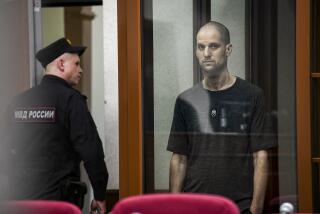The Year the Weather Turned in Moscow : If the Thaw Continues in ‘89, Gorbachev Can Go for Higher Stakes
- Share via
OXFORD, England — If 1987 was the year in which radical economic reform and serious political reform were put onto the agenda in the Soviet Union more firmly than ever before, 1988 was the year in which Mikhail S. Gorbachev was to discover just how difficult a task the politics of reconstructing the Soviet system (or perestroika ) was going to be. But 1988 was also the time in which those attempting to stem the tide of reform were to learn what a skillful and tough politician they were up against.
In spite of political difficulties (including serious ethnic tensions and popular discontent over stagnating living standards) and a natural disaster (the Armenian earthquake), Gorbachev ended the year in a stronger position institutionally than he began it.
Encouraged by the removal from the top leadership team of the former Moscow party first secretary--the forthright but impetuous reformer, Boris Yeltsin--in February, Gorbachev’s enemies prepared to consolidate the counterrevolution. They widely disseminated a neo-Stalinist article by an obscure Leningrad lecturer, Nina Andreyeva, which was later rightly described as the “manifesto of those conservative forces opposed to perestroika. “ The sharp rebuttal of that document in an anonymous Pravda article (the work of Gorbachev’s close Politburo ally, Alexander N. Yakovlev) reassured those who had begun to fear that the thaw was already over and that the political weather, resuming a cycle long familiar in Russian and Soviet history, was beginning to freeze once more.
The 19th party conference at the end of June and beginning of July saw a further enhancement of Gorbachev’s authority. But what really made this meeting a remarkable milestone of perestroika was that for the first time in 60 years such an authoritative party forum was also the arena of real debate. Gorbachev himself was not criticized openly by name (though several of his colleagues in the leadership were), but he was the unnamed target in a number of attacks on the policies that he had already espoused.
The conference--and a Central Committee plenary session a month later, which made some of the conference decisions more concrete--strengthened Gorbachev’s position by adopting in principle a series of political reforms. They authorized the creation of a new-style presidency (destined to have Gorbachev as its first occupant) and something rather more like a parliament than the Soviet Union has hitherto known.
Within the last three months reform has been taken further. In his travels throughout the Soviet Union in September, Gorbachev was taken aback by the often skeptical and sometimes hostile reception that he received from those who held that perestroika was something happening, perhaps, in Moscow but not much in evidence in the more distant parts of the country. This strengthened his resolve to press ahead with personnel changes and with a shake-up of the party bureaucracy. The changes at the top of the party hierarchy, including the compulsory retirement of several of its most conservative figures, strengthened the reformist wing of the leadership and enabled Gorbachev to succeed Andrei Gromyko as the head of state.
A remarkable streamlining of the party apparatus has also reduced the number of departments in the Central Committee building by about 60% and the staff by approximately 50% (achieved by retiring or redeploying 60% of the officials and making room for a 10% infusion of new blood). Given what most observers of the Soviet scene thought they knew about the power of the party bureaucracy to protect its interests, that was a rapier thrust by Gorbachev of almost staggering incisiveness.
Unlike Leonid I. Brezhnev, who always played safe and whose highest ambition appeared to be to die in office at a ripe old age, Gorbachev is playing for higher stakes. He wants not only office but also power--the power to reconstruct the Soviet system.
At the heart of that system, in Moscow, Gorbachev has already made an amazing amount of progress--not in turning around the faltering Soviet economy (a longer-term task) but in changing the balance of power and influence at the center and in making a significant start with political reform.
It is far from Moscow, however, that his most severe tests have come--in Armenia and Azerbaijan and in the Baltic republics. It would be difficult to deny that Gorbachev has been the most outstanding world leader of 1988, but, though--in one of his many pragmatic deviations from the political style of his predecessors--he has acknowledged that “politics is the art of the possible,” there must have been times at which he has wondered whether it is not “the art of the impossible.”
He knows that perestroika has aroused long-dormant hopes and expectations in the minds of many Soviet nationalities. It has produced cross-currents capable of engulfing all but a master mariner. If Gorbachev can this year begin to channel those currents into movement for constructive change, he will have met the toughest of all the challenges now facing him.
More to Read
Sign up for Essential California
The most important California stories and recommendations in your inbox every morning.
You may occasionally receive promotional content from the Los Angeles Times.













